MENU
The Electronic Scholarly Publishing Project: Providing access to classic scientific papers and other scholarly materials, since 1993. More About: ESP | OUR CONTENT | THIS WEBSITE | WHAT'S NEW | WHAT'S HOT
Comparative Timelines
The ESP Timeline (one of the site's most popular features) has been completely updated to allow the user to select (using the timeline controls above each column) different topics for the left and right sides of the display.
Select:
New Left Column
New Left Column
Dates
Decade
New Right Column
New Right Column
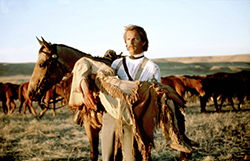 Dances With Wolves wins Academy Award for best picture. No major studio wanted to make the film, but the Kevin Costner-directed Western proved a huge hit with audiences and earned 12 Oscar nominations, winning seven.
Dances With Wolves wins Academy Award for best picture. No major studio wanted to make the film, but the Kevin Costner-directed Western proved a huge hit with audiences and earned 12 Oscar nominations, winning seven.
1990
(no entry for this year)
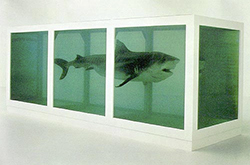 Scultpure by Damien Hirst: The Physical Impossibility of Death in the Mind of Someone Living consists of a large (14 foot) tiger shark preserved in formaldehyde in a vitrine. It is considered the iconic work of British art in the 1990s, and has become a symbol of Britart worldwide. The work was funded by Charles Saatchi, who in 1991 had offered to pay for whatever artwork Hirst wanted to create. Saatchi sold the work in 2004 to Steven A. Cohen for an estimated $8 million. When the original shark showed signs of deterioration (it rotted from the inside out and a fin fell off), it was replaced with a new specimen in 2006, thereby raising a Ship of Theseus problem: Does a work of art remain the same work if its components are replaced with new components?
Scultpure by Damien Hirst: The Physical Impossibility of Death in the Mind of Someone Living consists of a large (14 foot) tiger shark preserved in formaldehyde in a vitrine. It is considered the iconic work of British art in the 1990s, and has become a symbol of Britart worldwide. The work was funded by Charles Saatchi, who in 1991 had offered to pay for whatever artwork Hirst wanted to create. Saatchi sold the work in 2004 to Steven A. Cohen for an estimated $8 million. When the original shark showed signs of deterioration (it rotted from the inside out and a fin fell off), it was replaced with a new specimen in 2006, thereby raising a Ship of Theseus problem: Does a work of art remain the same work if its components are replaced with new components?
 The Silence of the Lambs wins Academy Award for best picture. It became the third and final film to win Oscar's top five prizes (film, director, script, actor, and actress). It was a surprise win because suspense thrillers were not considered Academy favorites, and Silence had opened in February; but the film maintained its enthusiastic buzz for more than a year.
The Silence of the Lambs wins Academy Award for best picture. It became the third and final film to win Oscar's top five prizes (film, director, script, actor, and actress). It was a surprise win because suspense thrillers were not considered Academy favorites, and Silence had opened in February; but the film maintained its enthusiastic buzz for more than a year.
1991
 Scultpure by Damien Hirst: The Physical Impossibility of Death in the Mind of Someone Living consists of a large (14 foot) tiger shark preserved in formaldehyde in a vitrine. It is considered the iconic work of British art in the 1990s, and has become a symbol of Britart worldwide. The work was funded by Charles Saatchi, who in 1991 had offered to pay for whatever artwork Hirst wanted to create. Saatchi sold the work in 2004 to Steven A. Cohen for an estimated $8 million. When the original shark showed signs of deterioration (it rotted from the inside out and a fin fell off), it was replaced with a new specimen in 2006, thereby raising a Ship of Theseus problem: Does a work of art remain the same work if its components are replaced with new components?
Scultpure by Damien Hirst: The Physical Impossibility of Death in the Mind of Someone Living consists of a large (14 foot) tiger shark preserved in formaldehyde in a vitrine. It is considered the iconic work of British art in the 1990s, and has become a symbol of Britart worldwide. The work was funded by Charles Saatchi, who in 1991 had offered to pay for whatever artwork Hirst wanted to create. Saatchi sold the work in 2004 to Steven A. Cohen for an estimated $8 million. When the original shark showed signs of deterioration (it rotted from the inside out and a fin fell off), it was replaced with a new specimen in 2006, thereby raising a Ship of Theseus problem: Does a work of art remain the same work if its components are replaced with new components?
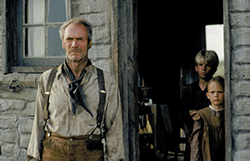 Unforgiven wins Academy Award for best picture. Clint Eastwood had directed 15 films in the past 20 years, earning industry respect and affection, but few awards. However, the thoughtful, well-crafted Unforgiven proved irresistible to audiences and to Academy voters. Since it was the second western to win in three years, some predicted a major big-screen revival of the genre, but that didn t happen.
Unforgiven wins Academy Award for best picture. Clint Eastwood had directed 15 films in the past 20 years, earning industry respect and affection, but few awards. However, the thoughtful, well-crafted Unforgiven proved irresistible to audiences and to Academy voters. Since it was the second western to win in three years, some predicted a major big-screen revival of the genre, but that didn t happen.
1992
(no entry for this year)
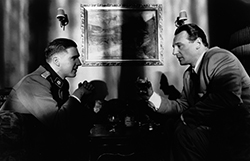 Schindler's List wins Academy Award for best picture. The Steven Spielberg film defied conventional wisdom, by being a long, black and white movie about a depressing topic. But it was a hugely popular win.
Schindler's List wins Academy Award for best picture. The Steven Spielberg film defied conventional wisdom, by being a long, black and white movie about a depressing topic. But it was a hugely popular win.
1993
(no entry for this year)
 Forrest Gump wins Academy Award for best picture. The Robert Zemeckis-directed film, starring Tom Hanks, utilized many technical innovations, but Oscar voters responded more to the tale and to the title character than to the decade-spanning effects.
Forrest Gump wins Academy Award for best picture. The Robert Zemeckis-directed film, starring Tom Hanks, utilized many technical innovations, but Oscar voters responded more to the tale and to the title character than to the decade-spanning effects.
1994
(no entry for this year)
 Braveheart wins Academy Award for best picture. The biopic, directed by Mel Gibson, was a popular winner in a tight year. It's also one of the few films to win Oscar's top prize without a single acting nomination, alongside Last Emperor, Slumdog Millionaire, and a few others.
Braveheart wins Academy Award for best picture. The biopic, directed by Mel Gibson, was a popular winner in a tight year. It's also one of the few films to win Oscar's top prize without a single acting nomination, alongside Last Emperor, Slumdog Millionaire, and a few others.
1995
(no entry for this year)
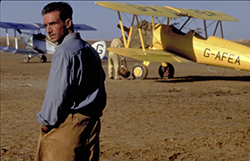 The English Patient wins Academy Award for best picture. The film almost wasn t made, when the studio withdrew funding at the last minute. But Harvey Weinstein stepped in, and the film (directed by Anthony Minghella) earned an impressive $232 million worldwide, and scored nine Oscars meaning it's one of the top seven winners of all time.
The English Patient wins Academy Award for best picture. The film almost wasn t made, when the studio withdrew funding at the last minute. But Harvey Weinstein stepped in, and the film (directed by Anthony Minghella) earned an impressive $232 million worldwide, and scored nine Oscars meaning it's one of the top seven winners of all time.
1996
(no entry for this year)
 Shakespeare in Love wins Academy Award for best picture. It was a battle between Steven Spielberg's Saving Private Ryan and Shakespeare in Love, and many were stunned when the comedy won. But it shouldn t have been a surprise: The film is a love letter to theater and acting, and the largest branch of the Academy is actors.
Shakespeare in Love wins Academy Award for best picture. It was a battle between Steven Spielberg's Saving Private Ryan and Shakespeare in Love, and many were stunned when the comedy won. But it shouldn t have been a surprise: The film is a love letter to theater and acting, and the largest branch of the Academy is actors.
1998
(no entry for this year)
 American Beauty wins Academy Award for best picture. The dramedy looked at all the dark longings beneath the sunny facade of U.S. suburbia.
American Beauty wins Academy Award for best picture. The dramedy looked at all the dark longings beneath the sunny facade of U.S. suburbia.
1999
(no entry for this year)
ESP Quick Facts
ESP Origins
In the early 1990's, Robert Robbins was a faculty member at Johns Hopkins, where he directed the informatics core of GDB — the human gene-mapping database of the international human genome project. To share papers with colleagues around the world, he set up a small paper-sharing section on his personal web page. This small project evolved into The Electronic Scholarly Publishing Project.
ESP Support
In 1995, Robbins became the VP/IT of the Fred Hutchinson Cancer Research Center in Seattle, WA. Soon after arriving in Seattle, Robbins secured funding, through the ELSI component of the US Human Genome Project, to create the original ESP.ORG web site, with the formal goal of providing free, world-wide access to the literature of classical genetics.
ESP Rationale
Although the methods of molecular biology can seem almost magical to the uninitiated, the original techniques of classical genetics are readily appreciated by one and all: cross individuals that differ in some inherited trait, collect all of the progeny, score their attributes, and propose mechanisms to explain the patterns of inheritance observed.
ESP Goal
In reading the early works of classical genetics, one is drawn, almost inexorably, into ever more complex models, until molecular explanations begin to seem both necessary and natural. At that point, the tools for understanding genome research are at hand. Assisting readers reach this point was the original goal of The Electronic Scholarly Publishing Project.
ESP Usage
Usage of the site grew rapidly and has remained high. Faculty began to use the site for their assigned readings. Other on-line publishers, ranging from The New York Times to Nature referenced ESP materials in their own publications. Nobel laureates (e.g., Joshua Lederberg) regularly used the site and even wrote to suggest changes and improvements.
ESP Content
When the site began, no journals were making their early content available in digital format. As a result, ESP was obliged to digitize classic literature before it could be made available. For many important papers — such as Mendel's original paper or the first genetic map — ESP had to produce entirely new typeset versions of the works, if they were to be available in a high-quality format.
ESP Help
Early support from the DOE component of the Human Genome Project was critically important for getting the ESP project on a firm foundation. Since that funding ended (nearly 20 years ago), the project has been operated as a purely volunteer effort. Anyone wishing to assist in these efforts should send an email to Robbins.
ESP Plans
With the development of methods for adding typeset side notes to PDF files, the ESP project now plans to add annotated versions of some classical papers to its holdings. We also plan to add new reference and pedagogical material. We have already started providing regularly updated, comprehensive bibliographies to the ESP.ORG site.
ESP Picks from Around the Web (updated 06 MAR 2017 )
Old Science

Weird Science

Treating Disease with Fecal Transplantation
Fossils of miniature humans (hobbits) discovered in Indonesia

Dinosaur tail, complete with feathers, found preserved in amber.
Astronomy

Mysterious fast radio burst (FRB) detected in the distant universe.